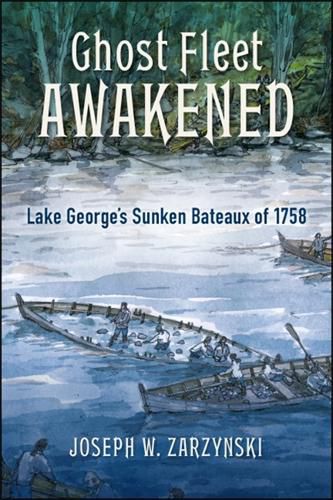Readings Newsletter
Become a Readings Member to make your shopping experience even easier.
Sign in or sign up for free!
You’re not far away from qualifying for FREE standard shipping within Australia
You’ve qualified for FREE standard shipping within Australia
The cart is loading…






This title is printed to order. This book may have been self-published. If so, we cannot guarantee the quality of the content. In the main most books will have gone through the editing process however some may not. We therefore suggest that you be aware of this before ordering this book. If in doubt check either the author or publisher’s details as we are unable to accept any returns unless they are faulty. Please contact us if you have any questions.
In Ghost Fleet Awakened, Joseph W. Zarzynski reveals the untold story of a little-recognized sunken fleet of British warships, bateaux, from the French and Indian War (1755-1763). The story begins more than 250 years ago, when bateaux first plied the waters of Lake George, New York. Zarzynski enlightens readers with a history of these utilitarian vessels, considered the most important vessels that transported armies during eighteenth-century wars in North America, and includes their origins and uses. By infusing the book with underwater archaeology doctrine, Zarzynski shows the nautical significance of these colonial craft.
In the autumn of 1758, the British command at Lake George made a daring decision to deliberately sink two floating batteries (radeaux), some row galleys and whaleboats, a sloop, and 260 bateaux, thereby placing the warships into wet storage and protecting them from marauding French during the coming winter. In 1759, many submerged boats were raised but some were not. Then, in 1960, two divers rediscovered several sunken bateaux, dubbed the Ghost Fleet. These shipwrecks were the focus of underwater archaeological investigations that provided archaeologists with opportunities to gain unprecedented insight into eighteenth-century lifeways. Zarzynski explores and explains shipwreck preservation techniques, the creation of shipwreck parks for scuba enthusiasts, and the many multifaceted programs developed by the nonprofit organization Bateaux Below to help protect these finite cultural treasures.
$9.00 standard shipping within Australia
FREE standard shipping within Australia for orders over $100.00
Express & International shipping calculated at checkout
This title is printed to order. This book may have been self-published. If so, we cannot guarantee the quality of the content. In the main most books will have gone through the editing process however some may not. We therefore suggest that you be aware of this before ordering this book. If in doubt check either the author or publisher’s details as we are unable to accept any returns unless they are faulty. Please contact us if you have any questions.
In Ghost Fleet Awakened, Joseph W. Zarzynski reveals the untold story of a little-recognized sunken fleet of British warships, bateaux, from the French and Indian War (1755-1763). The story begins more than 250 years ago, when bateaux first plied the waters of Lake George, New York. Zarzynski enlightens readers with a history of these utilitarian vessels, considered the most important vessels that transported armies during eighteenth-century wars in North America, and includes their origins and uses. By infusing the book with underwater archaeology doctrine, Zarzynski shows the nautical significance of these colonial craft.
In the autumn of 1758, the British command at Lake George made a daring decision to deliberately sink two floating batteries (radeaux), some row galleys and whaleboats, a sloop, and 260 bateaux, thereby placing the warships into wet storage and protecting them from marauding French during the coming winter. In 1759, many submerged boats were raised but some were not. Then, in 1960, two divers rediscovered several sunken bateaux, dubbed the Ghost Fleet. These shipwrecks were the focus of underwater archaeological investigations that provided archaeologists with opportunities to gain unprecedented insight into eighteenth-century lifeways. Zarzynski explores and explains shipwreck preservation techniques, the creation of shipwreck parks for scuba enthusiasts, and the many multifaceted programs developed by the nonprofit organization Bateaux Below to help protect these finite cultural treasures.